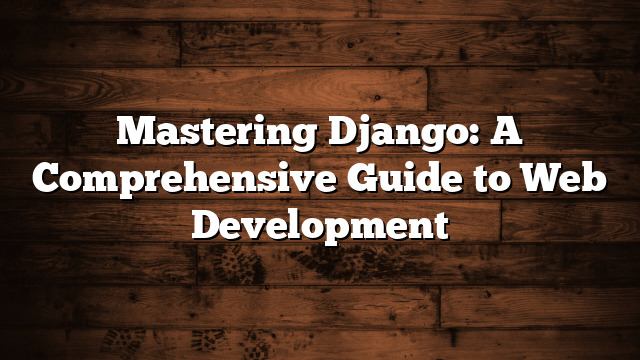In the realm of web development, Django stands tall as a powerful and versatile framework that empowers developers to create robust and dynamic web applications. Born out of the pragmatic needs of newsroom developers at the Lawrence Journal-World, Django has evolved into a full-fledged toolkit that simplifies the complex process of building web applications. In this comprehensive guide, we will delve into the world of Django and explore how it plays a pivotal role in modern web development.
Understanding Django: The Web Developer’s Swiss Army Knife
Django, named after the famed jazz guitarist Django Reinhardt, is an open-source Python framework designed to facilitate rapid web development. It adheres to the principle of DRY (Don’t Repeat Yourself) by providing a clean and efficient coding structure. By following the “batteries-included” philosophy, Django offers a plethora of built-in tools, libraries, and functionalities that streamline various aspects of web development, from handling user authentication to managing database interactions.
The Pillars of Django: Models, Views, and Templates
At the heart of Django’s architecture lies the MVT (Model-View-Template) design pattern. Similar to the MVC (Model-View-Controller) pattern, MVT separates the application into distinct layers, allowing for modular and organized code.
Models
Models define the structure of the application’s data, essentially acting as a representation of the database schema. Django’s Object-Relational Mapping (ORM) system enables developers to interact with the database using Python classes, eliminating the need for raw SQL queries.
Views
Views handle the logic of processing incoming requests and returning appropriate responses. In Django, views are Python functions that can render templates, retrieve data from models, and perform various operations before sending a response to the client.
Templates
Templates are responsible for presenting the data to the user in a visually appealing manner. Django’s template engine provides a flexible and dynamic way to create HTML pages by integrating data from the views.
Building Dynamic Web Applications with Django
Creating a Django Project
The journey begins with setting up a Django project. The django-admin command-line tool makes it effortless to create the project’s foundation, complete with the necessary configurations.
Designing the Data Models
Django’s ORM simplifies the creation and management of database tables, allowing developers to define models using Python classes. The makemigrations and migrate commands enable seamless synchronization between the models and the actual database schema.
Crafting Views and Templates
Views serve as the bridge between models and templates. By creating view functions and associating them with URLs, developers can control how data is processed and presented to users. Templates, driven by Django’s template language, provide the visual structure for the application’s user interface.
Navigating the Admin Panel
Django’s admin panel is an out-of-the-box feature that offers a user-friendly interface for managing application data. Developers can customize the admin panel to align with the application’s specific requirements.
Handling User Authentication
Security is paramount in web development. Django simplifies user authentication by providing pre-built tools for managing user registration, login, and password reset functionalities.
Integrating Frontend and Backend
Django is backend-agnostic, meaning it can be combined with various frontend technologies. By utilizing Django’s REST framework, developers can create powerful APIs that enable seamless communication between the frontend and backend components.
Testing and Deployment
Django encourages a test-driven development approach. The framework offers comprehensive testing tools that aid in creating robust and bug-free applications. Once the application is ready, Django’s deployment guidelines ensure a smooth transition from development to production.
Conclusion
In the ever-evolving landscape of web development, Django remains a steadfast and innovative tool for building dynamic web applications. Its commitment to efficiency, modularity, and security makes it a top choice for developers seeking to master the art of crafting sophisticated and powerful online platforms. Through its seamless integration of models, views, and templates, Django empowers developers to transform ideas into functional and visually appealing web applications, thereby cementing its place as a cornerstone of modern web development. So, dive into the world of Django, and unlock the potential to create web experiences that captivate and engage users in ways beyond imagination.
#web development
#django















